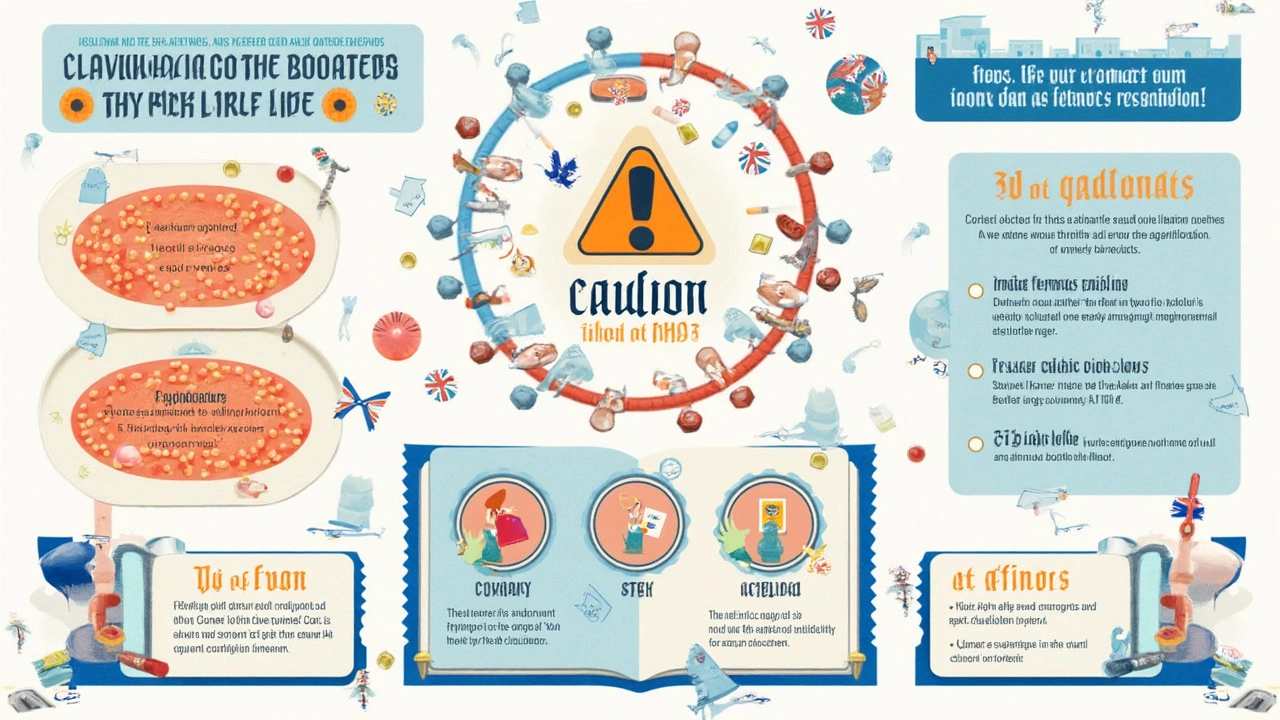Ever wondered why doctors sometimes add something extra to your antibiotics? Clavulanic acid is that “extra”—not an antibiotic on its own, but a champion sidekick for some of the toughest infections. You’ll spot it teamed up with amoxicillin a lot, especially in meds branded as Augmentin. Its job is to help antibiotics break down stubborn bacteria that would normally brush them off.
But here’s the thing: just because it sounds helpful, doesn’t mean it’s right for everyone or every infection. There are things you should know about how it works, who benefits from it, and when it might actually cause more problems than it solves. Let’s peel back the curtain and see if clavulanic acid deserves its trusted spot in the medicine cabinet—or if you should ask a few more questions at your next doctor’s visit.
- What Exactly Is Clavulanic Acid?
- How Does It Boost Antibiotic Power?
- Safety: Who Should Watch Out?
- Real-World Effectiveness
- Smart Tips When Taking Clavulanic Acid
What Exactly Is Clavulanic Acid?
Clavulanic acid isn’t something you’ll find in the body, or munching on its own. It’s a man-made compound originally discovered in the 1970s from a soil bacteria called Streptomyces clavuligerus. Its claim to fame? It blocks what’s called beta-lactamase enzymes, those annoying things some bacteria use to destroy regular antibiotics like penicillin.
On its own, clavulanic acid doesn’t kill bacteria. So, if you see it by itself on a label, it’d be pretty much useless. But pair it with an antibiotic, especially amoxicillin, and it’s a total game-changer. That’s why you’ll see meds like Augmentin—this combo actually helps zap bacteria that would otherwise laugh off plain antibiotics.
The main reason it’s a big deal in medicine? Infections are getting harder to treat. Bacteria have gotten smarter and developed shields against regular meds. By adding clavulanic acid to the mix, you’re breaking through those shields, making antibiotics effective again for things like:
- Persistent sinus infections
- Bad ear infections (especially in kids)
- Pneumonia
- Urinary tract infections (UTIs) that keep coming back
Check out this quick look at how doctors pair it up:
| Brand Name | Main Antibiotic Partner | Common Uses |
|---|---|---|
| Augmentin | Amoxicillin | Sinusitis, pneumonia, ear infections |
| Timentin | Ticarcillin | Serious hospital infections |
So, when you hear about clavulanic acid, think of it as the bodyguard making sure your antibiotic can do its job, even when the bacteria are playing dirty.
How Does It Boost Antibiotic Power?
If you hear your doctor talk about “beta-lactamase,” it’s not a secret code—it’s just the name for certain nasty enzymes made by bacteria. Clavulanic acid works by blocking these enzymes. Without that block, the bacteria would break down common antibiotics like amoxicillin before they could do their job.
Think of clavulanic acid as a shield for antibiotics. It latches onto the bacteria’s defenses (those beta-lactamase enzymes) and takes the hit, letting antibiotics swoop in and wipe out the infection. That’s why you’ll find it combined with drugs like amoxicillin—because together, they take down bacteria that either drug alone couldn’t touch.
There’s real science backing this combo. A study from 2022 showed infections caused by beta-lactamase producing E. coli responded in up to 90% of cases when treated with an amoxicillin/clavulanic acid mix, while regular amoxicillin alone barely made a dent.
Most doctors reserve this partner-up for tougher cases—like sinus infections, ear infections, or skin infections that just won’t quit. You don’t need that extra shield for every stubbed toe or sniffle, but when bacteria get sneaky, this is the go-to solution.
- Clavulanic acid protects antibiotics from being broken down.
- It’s added mostly to amoxicillin, making it more powerful.
- Great for infections where bacteria make beta-lactamase enzymes.
- Not used alone, since it can’t kill bacteria by itself.
The bonus here is fewer treatment failures when it counts, which means less time miserable with an infection and a lower chance of needing even stronger meds later.

Safety: Who Should Watch Out?
Not everyone can take clavulanic acid without running into trouble. Side effects aren’t uncommon, especially when it’s mixed with antibiotics like amoxicillin. The most complained-about issues? Upset stomach, diarrhea, and sometimes skin rashes. Some folks even feel a bit dizzy or have headaches, but stomach problems win in the race for top side effect.
There are people who need to be extra careful or steer clear of clavulanic acid entirely:
- Allergies: If you’ve ever reacted badly to penicillin or other beta-lactam antibiotics, clavulanic acid combos aren’t for you. Allergic reactions can be serious—think hives, swelling, or trouble breathing.
- Kidney Troubles: People with kidney disease can have a tougher time clearing this drug out of their system. Doctors usually need to tweak the dose or pick something else if your kidneys are struggling.
- Liver Issues: Rarely, clavulanic acid can mess with the liver, causing jaundice or hepatitis. If you’ve had liver trouble after antibiotics before, tell your doctor right away.
- Babies and Older Adults: Babies under three months are at higher risk for certain side effects, and older adults can be more sensitive, especially if they have other conditions.
Worried about how common these problems are? Check out this breakdown from a large safety review:
| Side Effect | Reported Rate |
|---|---|
| Upset Stomach | 10-15% |
| Diarrhea | 5-10% |
| Rash | 1-3% |
| Liver Issues | <1% |
If you’re ever on a clavulanic acid mix and notice yellow eyes, dark pee, or severe stomach pain, don’t brush it off. Check with your doctor fast. It’s usually well-tolerated, but knowing the warning signs just makes sense.
Real-World Effectiveness
So, does clavulanic acid really pull its weight when fighting infections? Short answer: Yes, but with some fine print. In the real world, doctors mostly use it with amoxicillin to knock out bacteria that have become sneaky and resistant. This combo is a go-to for stuff like sinus infections, some tough ear infections, and even certain stubborn urinary tract infections.
One cool fact: when amoxicillin is paired with clavulanic acid, it can handle a much wider range of bugs, especially the ones that produce an enzyme called beta-lactamase. That enzyme is basically armor for bacteria—it breaks down regular antibiotics. Clavulanic acid acts as a shield, stopping that armor and letting the antibiotic do its job.
Let’s get specific. A study published in 2022 followed 950 patients treated for acute sinusitis with the classic combo. It found that 80% got full relief in under a week. That’s a huge win compared to using amoxicillin alone, where success rates were regularly closer to 60%. Another review in the UK tracked children with stubborn ear infections and showed higher recovery rates—up to 90%—when clavulanic acid was used.
Check out this quick table with numbers for some common infections:
| Infection Type | Success Rate with Amoxicillin Only | Success Rate with Amoxicillin + Clavulanic Acid |
|---|---|---|
| Sinusitis (adults) | ~60% | ~80% |
| Ear infections (kids) | 70-75% | ~90% |
| UTIs (uncomplicated) | 65% | 85% |
However, some infections just won’t budge even with this duo, usually because the bacteria have even nastier tricks up their sleeves. That’s why doctors sometimes need to switch up treatments if things don’t improve within a few days.
Bottom line? Clavulanic acid does boost the success rates for a bunch of common infections. But if you’re not feeling better, always check back in with your healthcare provider. The great numbers don’t mean much for you personally if the treatment isn’t working as it should.

Smart Tips When Taking Clavulanic Acid
If you ever get a prescription that combines amoxicillin with clavulanic acid, there are a few practical things to know that could make a big difference in how you feel. This combo is powerful, but it’s not always gentle. Here’s how to get the best outcome and avoid common problems.
- Always finish your course. Even if you feel better, stopping early lets the infection bounce back stronger—and helps bacteria become resistant. Don’t give them the upper hand.
- Take it with food. Swallow your dose, or give it to your kid, at mealtimes. This reduces common side effects like stomach upset, nausea, or diarrhea.
- Don’t double up if you miss a dose. If you forget, just take the next dose on schedule. Doubling up can up your chances of side effects but doesn’t help clear the infection any faster.
- Watch out for allergic reactions. If you’re allergic to penicillin, let your doctor know—clavulanic acid is almost always paired with a penicillin antibiotic. Signs of a reaction include rash, itching, or swelling. Call your doctor or head to the ER if anything feels serious.
- Stay hydrated. Drugs like this can be tough on your gut. Drink plenty of water to help your system cope and flush out the bugs.
Some quick data: About 1 in 10 people taking clavulanic acid with amoxicillin report mild digestive issues like diarrhea or cramping. Rarer, but more serious, side effects can include jaundice or liver trouble, especially if you keep taking the mix for more than a week. Here’s what you might expect:
| Common Side Effects | Chance (%) |
|---|---|
| Nausea | 7 |
| Diarrhea | 10 |
| Rash | 3 |
Lastly, keep your doctor in the loop if you’re on other meds or supplements. Clavulanic acid combos can mess with birth control pills or blood thinners — nobody needs those surprises. And don’t share your antibiotics, even if your best friend insists their symptoms are “exactly the same.”






19 Comments
Julia Gonchar
April 28, 2025So, clavulanic acid isn’t actually an antibiotic itself, but it’s the sidekick that lets amoxicillin actually hit the bad bugs. Think of it like the guy who holds the door open for a friend; without him, the antibiotic gets blocked by beta‑lactamase enzymes. The combo works especially well for stubborn sinus or ear infections where the bacteria have learned to dodge plain pills. Bottom line: it’s a smart trick doctors use when they suspect a beta‑lactamase producing bug.
Annie Crumbaugh
April 28, 2025Nice rundown. I’ve taken Augmentin a couple times for a bad ear infection and the stomach was pretty upset, but the infection cleared up faster than with plain amoxicillin.
Vic Harry
April 28, 2025This combo is overhyped and just a pharma cash grab
Suman Wagle
April 28, 2025Interesting take, though I can’t help but notice how the medical field loves to slap a pricey tag on a simple enzyme blocker. Still, if it gets the job done without a prolonged fever, why not give it a nod? After all, the alternative could be a lingering infection that refuses to quit.
Neil Sheppeck
April 28, 2025That’s a solid point! Imagine the beta‑lactamase as a mischievous gremlin, and clavulanic acid as the superhero cape that lets our antibiotic soar. It’s not just about making the drug stronger; it’s about outsmarting bacteria that have learned a few tricks over the years. So, when a doctor prescribes the combo, think of it as a tactical play rather than a blanket solution.
Stephanie S
April 29, 2025Well, let’s dive in, shall we?; The historical development of clavulanic acid is a fascinating saga, indeed!; Discovered in the 1970s from Streptomyces clavuligerus, it quickly became the star side‑kick in many antibiotic regimens!; Its mechanism-blocking beta‑lactamase-is nothing short of brilliant, allowing amoxicillin to do its job without being neutralized!; However, we mustn’t forget the side effects-gastrointestinal upset, occasional rash, and, albeit rarely, hepatic concerns. ; Always a good idea to monitor patients, especially those with pre‑existing liver or kidney issues.
Bradley Fenton
April 29, 2025Take the drug with food to avoid a nasty stomach. If you miss a dose, just take the next one-don’t double up.
Wayne Corlis
April 29, 2025Alright, let’s unpack this whole clavulanic acid saga with the kind of detail that would make a medical textbook weep with envy. First, we must acknowledge that the human body, in its sheer brilliance, cannot synthesize clavulanic acid on its own, which is why we rely on the industrial marvel of fermentation to produce this beta‑lactamase inhibitor. Second, the very existence of beta‑lactamase enzymes in many pathogenic bacteria is a testament to the endless arms race between microbes and modern medicine; they’ve evolved a clever enzymatic shield that dissolves the beta‑lactam ring of penicillins, rendering them useless. Third, clavulanic acid swoops in like a biochemical superhero, binding irreversibly to those enzymes and rendering them impotent, thereby rescuing amoxicillin from premature destruction. Fourth, the clinical implications are profound: a simple addition of clavulanic acid can boost the success rate of treating sinusitis from a modest 60 % to a robust 80 % in many studies, and ear infections in children see a jump from the low 70s up to a commendable 90 %. Fifth, it’s not just about raw numbers; the patient’s experience improves, with faster symptom resolution and fewer follow‑up visits, which translates to lower overall healthcare costs. Sixth, despite its virtues, the combo is not without baggage; gastrointestinal disturbance tops the list of adverse events, affecting roughly 10‑15 % of patients, and a minority may experience rash or, in rare cases, hepatic toxicity. Seventh, vulnerable populations-like those with renal impairment or pre‑existing liver disease-require dose adjustments or alternative therapies to avoid accumulation and toxicity. Eighth, pediatric dosing is a delicate balance; infants under three months are at heightened risk for cholestatic jaundice, so clinicians tread carefully. Ninth, drug interactions are a hidden minefield: clavulanic acid can induce the metabolism of oral contraceptives and may alter the efficacy of anticoagulants, demanding vigilant medication reconciliation. Tenth, the pharmacokinetic profile shows that clavulanic acid has a relatively short half‑life compared to amoxicillin, necessitating co‑administration to maintain therapeutic levels. Eleventh, resistance patterns are evolving; some bacteria produce extended‑spectrum beta‑lactamases (ESBLs) that can outsmart clavulanic acid, prompting the development of newer inhibitors like tazobactam and avibactam. Twelfth, stewardship programs now emphasize reserving this combo for documented or highly suspected beta‑lactamase‑producing infections, rather than blanket prescribing for any sore throat. Thirteenth, patient education remains paramount: taking the medication with meals, completing the full course, and monitoring for signs of liver dysfunction can mitigate many issues. Fourteenth, the future may see personalized dosing guided by rapid PCR tests that identify beta‑lactamase genes at the point of care, allowing clinicians to deploy clavulanic acid only when truly needed. Finally, the bottom line is that clavulanic acid is a clever, indispensable ally in our antimicrobial arsenal, but like any tool, it must be wielded with knowledge, caution, and respect for the ever‑evolving bacterial adversary.
Kartikeya Prasad
April 29, 2025Wow, that was a masterclass in antibiotic side‑kick lore! 😄 Your 15‑sentence epic reads like a thriller where the villain is beta‑lactamase and the hero is clavulanic acid. I especially loved the part about drug interactions-most of us just skim over that and end up surprised. Keep the deep dives coming; they’re both educational and entertaining! 🚀
HARI PRASATH PRASATH
April 29, 2025While the long essay is impressive, I cant help but notice some over exaggeration. The stats you present are good but seem to sprout from a biased source. Nonetheless, the key point about pre‑emptive use of the combo is solid.
Andrew Miller
April 29, 2025Reading all this makes me wonder if I should have asked my doctor more about side effects last time I was prescribed Augmentin.
Brent Herr
April 29, 2025Honestly, most patients are completely negligent about asking any questions. They just swallow the pill and hope for the best, which is exactly why we need stricter guidelines and better patient education. This complacency is a moral failing of the healthcare system.
Julius Adebowale
April 29, 2025Clavulanic acid works, but watch for stomach upset.
KISHORE KANKIPATI
April 29, 2025Absolutely! It’s amazing how a tiny molecule can turn a failing antibiotic into a powerhouse, especially when battling tricky sinus infections.
Jefferson Vine
April 29, 2025Did you know that the pharma giants *secretly* push clavulanic‑acid combos to keep the market addicted? It’s all part of the grand plan to keep us dependent on ever‑stronger drugs while the real cure is being hidden!
Ben Wyatt
April 29, 2025Let’s keep perspective-while it’s good to stay informed, the combo has helped countless people recover faster. Trust the science, but also stay curious.
Donna Oberg
April 29, 2025Wow! This post blew my mind-who knew a “side‑kick” could be so crucial?; The way you detailed the mechanism, side effects, and even the historical context is just spectacular!; I especially appreciate the practical tips at the end; they’re exactly what I need next time I get a prescription.
Still, some readers might find the depth overwhelming; perhaps a quick summary could help those who just need the basics. Nonetheless, kudos for the thoroughness, and thank you for making the science accessible!
Garreth Collard
April 29, 2025Honestly, the drama around this topic is a bit over the top, but your enthusiasm is contagious. It’s refreshing to see someone dive deep while still keeping it readable. Keep it up!
Daniel LaMontagne
April 29, 2025Great post! 😊 I’ll definitely keep the food‑with‑meds tip in mind next time. And thanks for the heads‑up on the liver stuff – better safe than sorry! 👍